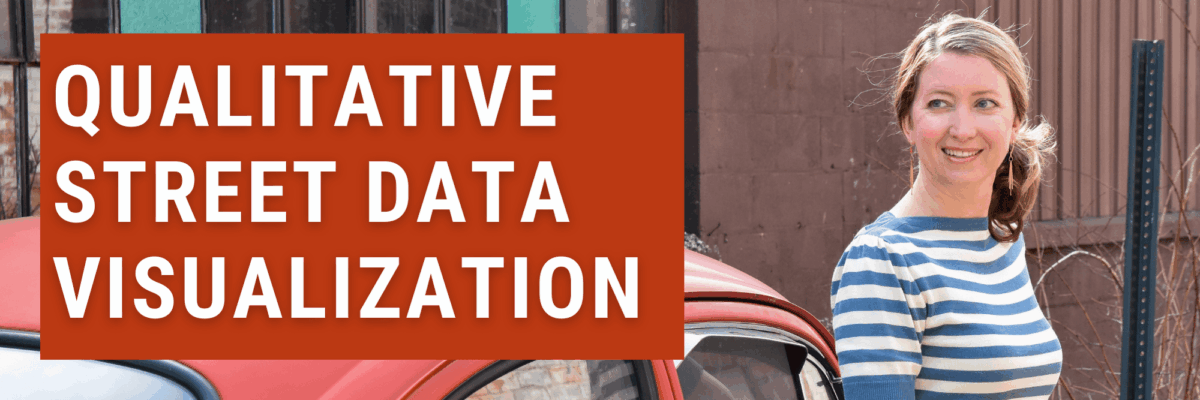Qualitative Street Data Visualization
If satellite data is stuff like standardized test scores and map data is akin to classroom satisfaction surveys, street data consists of the detailed stories gathered on the ground through qualitative inquiry.
Satellite, map, and street data are terms defined by Shane Safir and Jamila Dugan in their book about changing the education system to make it more equitable – but their lessons can apply to any place where you’re looking to make systemic change.
The authors advise that the way you’ll know what to change is by listening to the street – aka the people on the ground, in the thick of it every day. In schools, that would be students and families and teachers.
Who would that be in your organization?
As I was reading Street Data, my friend, my brain downloaded a ton of new ideas for visualizing the qualitative data the authors teach us how to collect. I’m sure these examples will have applications in your own work, even if it isn’t in a school system, so come with me.
Let me add three new qualitative data visualization ideas to your library.
Placement Maps
A placement map plots out where your units of analysis (students, in this case) sit in some defined space (like a classroom).

In Street Data, the authors call this particular version an Equity Participation Map.
You could absolutely add words or symbols to each student’s circle to code their race/class/gender/status to look for more nuanced patterns in who participates and who is asked to participate.
I’m using a broader term, Placement Map, because I’ve seen these used in other scenarios where the focus isn’t explicitly equity. Check out this visualization of which bus seats are most popular.

Imagine using this to diagram where cars (your unit of analysis) sit in a parking lot (your defined space).
Imagine using this to depict which employees (unit of analysis) speak up the most in meetings (your defined space).
Are you getting any ideas about how you could use this visual in your work?
Timeline Ticks
Timeline ticks help us visualize the answers to qualitative questions that start with “When was the last time you…?”
When was the last time you saw a doctor for routine care?
When was the last time you felt valued by your boss?
Or, in the case of a scenario discussed in Street Data, “When was the last time you felt that you could make a difference here about something that matters to you?”
We plot out answers, going back in time.

Though time isn’t necessarily linear, I started on the right with today and moved to the left, to travel backward. Each line is a different respondent. You could label them (with names or with, say, demographics, if you were tracking equity) or keep them anonymous.
Sliders
Not tiny burgers.
Sliders visualize answers to qualitative questions that begin with “To what extent….?”
To what extent do you believe vaccines prevent severe disease?
To what extent do you believe you’re a valued member of this organization?
When the authors of Street Data are trying to get a clear sense of students’ sense of agency in a school, they pose “To what extent do you feel like you belong here?” In addition to belonging, Street Data also asks a similar question about identity and efficacy.
Qualitative analysis might code the responses into categories like “Not very much” all the way to “Fully” and perhaps aggregate across a classroom or school.
I’d visualize that data in sliders, like this:

Street data is intended to help us get the fuller picture of what’s going on and we’re gonna need ways to actually visualize that fuller picture so we can generate action-oriented discussions about it.
I hope these three qualitative visuals support those conversations and reorientations and if you need even more qualitative data viz ideas, see my examples here and here.
This doesn’t have to be hard to be powerful.
I made the Timeline Ticks and Sliders using Excel.
I made the Placement Map in PowerPoint. Any program that lets you insert shapes and textboxes will do the trick. A copy of the teacher’s hand-drawn seating chart and some crayons would even do the trick.

These words, quoted in Street Data, came from Margaret Wheatley in her 2019 keynote at the British Columbia School Superintendents Association meeting.
We can’t collect that juicy street data and just let it sit in a recording somewhere or stack up in a pile of rubrics on a desk. Use these visuals to get it out in the world. Or we’ll end up relying on satellite data that misses the full mark.
PS. I’ve collected so many new ways to visualize qualitative data that I’ve now got a half-day qualitative data viz workshop. I’ll walk you through how to choose the right qualitative visual and exactly how to make it. Virtual or in-person. Or add this on to my regular data viz workshop. Here’s some info about what this workshop covers. Just a heads up, my schedule books about 8 months in advance.
Take a sneak peek and download my Qualitative Chart Chooser.


